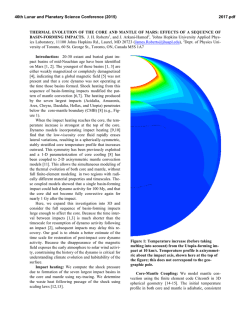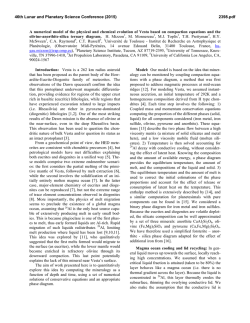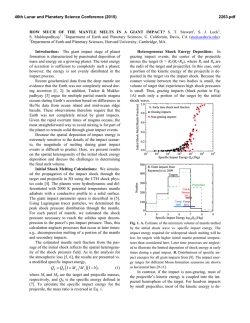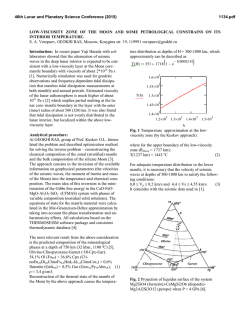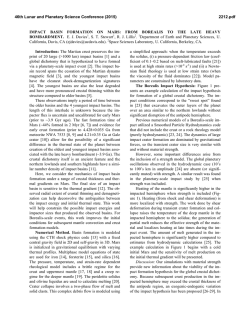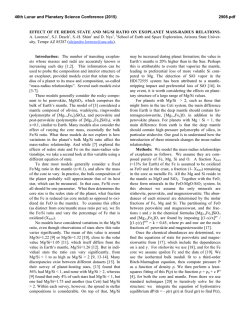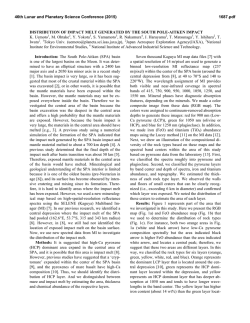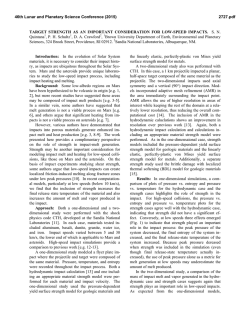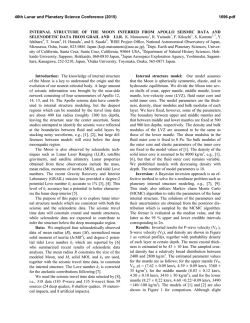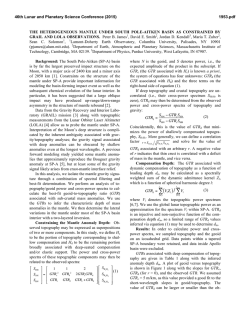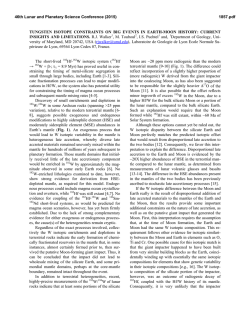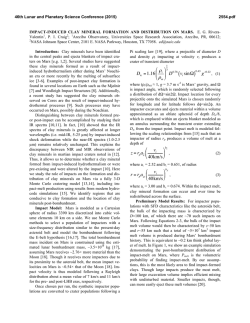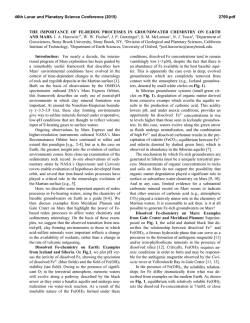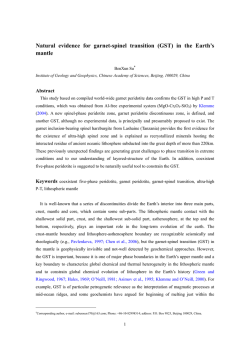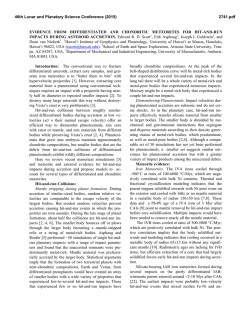
Core, Atmosphere, Mantle, Phobos, and Surface - USRA
46th Lunar and Planetary Science Conference (2015) 2900.pdf Mars Thermal History: Core, Atmosphere, Mantle, Phobos, and Surface (MaTH CAMPS). M. S. Duncan1, M. B. Weller1, J. K. Wicks2, N. R. Knezek3, B. A. Black3, S. A. Johnston4, S. Hongsresawat5, N. J. Towles6, C. Thissen7, N. C. Schmerr4, M. P. Panning5, L. Montési4, M. Manga3 and P. Lognonné8; 1Rice Univ., Houston, TX, USA; 2 Princeton Univ., Princeton, NJ, USA; 3Univ. of California, Berkeley, CA, USA; 4Univ. of Maryland College Park, College Park, MD, USA; 5Univ. of Florida, Gainesville, FL, USA; 6Johns Hopkins Univ., Baltimore, MD, USA; 7 Yale Univ., New Haven, CT, USA; 8Institut de Physique du Globe de Paris, Paris, France. Introduction: Evidence suggests that ancient Mars exhibited a core dynamo that shutoff by ~4.1 Ga [1]. In contrast, Martian magmatism persisted from Noachian through Amazonian time, as evidenced by the emplacement of Tharsis ~3-4 Ga and by volcanic eruptions with very young ages inferred from low crater densities, including a ~100 Ma eruption of Olympus Mons [2]. Canonical reasoning suggests that dynamo shutoff due to secular cooling accompanies a nearconcurrent cooling of the mantle, and consequently the end of melt generation and volcanism. Here we explore the hypothesis that a basal mantle layer enables a non-canonical thermal evolution of Mars, and could allow for both the early cessation of the dynamo and continued melt generation to the present day. The MaTH:CAMPS project integrates present-day observations of the geochemistry, magnetism, and geophysical properties of Mars to constrain the past evolution of Mars’ internal structure and thermal state. To simulate the coupled thermochemical evolution of the core and mantle of Mars, we develop one-dimensional models that allow for evolving core compositions and utilize parameterized convection [3] under endmember initial conditions. Core: The core model combines the effects of temperature and composition to determine the level of heat flux out of the core required to sustain the dynamo. Thermal Model: The dominant power sources for a core dynamo are thermal convection driven by secular cooling and compositional convection driven by core solidification. Compositional convection from core solidification is inconsistent with an early shutoff due to convective vigor and duration [4]. A thermallypowered dynamo requires superheated initial core states to satisfy the minimum heat flux of ~15 mW/m2 across the core-mantle boundary [5]. Mineralogical Model: The core was modeled as a Fe-Ni-S alloy, constrained by the Fe-FeS phase diagram which was compiled over 21-40 GPa from multiple experimental studies [6,7]. We consider a wide range of core sulfur contents from 5 wt.% [5] to 25.6 wt.%, which have a large impact on core size and crystallization scheme (freezing temperature), and density [8]. For low S contents (<12 wt.%), a dense Fe-Ni alloy will first precipitate at the top of the core. As cooling proceeds, the denser solid will ‘snow’ and collect as a solid inner core. For high S contents (>15 wt.%), FeS precipitates at the center of the core and rises cre- ating a solid outer core. At intermediate S contents, both processes will occur. Potential observations of core size and density from InSight will narrow the range of viable sulfur content and in turn determine mode and degree of crystallization. Mantle: We tested two initial conditions for Mars: a ‘hot’ start with a deep magma ocean that extended to the core-mantle boundary [9], and a ‘cold’ start or shallow magma ocean that extended only to the midmantle [10]. These two scenarios set the initial temperature profiles of the mantle and the basal layer composition. At present, we have only considered three compositional scenarios resulting from magma ocean crystallization. These are a homogenous mantle (no layer) resulting from crystallization of complete magma ocean, a basal garnet layer from a deep magma ocean, and a basal mélange layer (composed of ringwoodite, garnet, and Fe metal-possibly due to incomplete core formation) that resided beneath a shallow magma ocean and did not melt. We constructed a 1-D parameterized convection model of the mantle consisting of a stagnant ‘lid’, an upper (or homogeneous) mantle, a basal mantle layer, and a lookup interface with the core. Mantle physical properties were calculated for a Dreibus and Wänke [11] bulk composition using the thermodynamic modeling program HeFESTo [12], and the physical properties of the basal layer were calculated using EOS and parameters gathered from the literature appropriate for the desired composition. Comparison to Observations: Dynamo cessation: Cessation of a thermally generated dynamo occurs when core heat flow falls below a critical value (Fig. 1, dashed line). Figure 1. Mantle model results of heat flux from coremantle boundary for different starting T and layer compositions, calculated independently of the core thermal model. *Result of coupled core-mantle models with mélange layer. 46th Lunar and Planetary Science Conference (2015) Within the basal layer, low viscosities and high initial temperature contrasts (mélange layer; shallow magma ocean) can produce an early, short-lived dynamo. Conversely, high to uniform viscosities and moderate temperature contrasts (garnet layer or homogenous mantle; deep magma ocean) act to insulate the core and prevent sufficient heat flow for dynamo generation, requiring unrealistically high core temperatures to generate a dynamo. Continued mantle melting: Melt fraction (Fig. 2) as a function of radial layer is determined using the liquidus and solidus formulations of [13,14]. The basal mélange layer acts as a long-lived heat reservoir that extends melt production over a significant span of the Amazonian. A basal garnet layer or a homogenous mantle result in high melt production in the Noachian, but little to no melt produced through to the Amazonian. Figure 2. Mantle model results of mantle melt generation (when model T is above solidus T). Mass and Moment of Inertia: Using the mélange model, mass and moment inertia of Mars are calculated as a function of varying core radius and crustal thickness (Fig. 3), and in turn compared to known values (blue/red represents low/high misfit). The best fit model (from the combined misfit of mass and moment of inertia) gives us a prediction of internal structure and properties for direct comparison for the InSight mission in 2016 which will allow us to test our models of Martian formation scenarios. Figure 3. Results or model calculations of mass (left), moment of inertia (middle), and normalized misfit (right) for a fixed crustal density of 2800 kg/m3, a mantle density calculated for a DW composition in HeFESTo, and a mélange layer consisting of 1/3 ringwoodite+1/3 garnet+1/3 Fe metal. For a core radius of 1500 km (14 wt.% S), the crust is required to be 120 km thick; thicker than previous estimates 2900.pdf [15], giving constraints on the basal layer composition (i.e., less Fe). Future Steps: Core and Mantle: We will work to fully couple the core and mantle models, and include the effects of core solidification and parameterized melt migration to the thermal model. We will also consider the effects of magma ocean overturn which will place a dense, relatively cool layer at the base of the mantle [16]. We will test the sensitivity of heat flux and melt production to the composition and initial temperature we assume. Surface/Lithosphere: Using a modified lithospheric stress code [17] we will compare timing of the thermal and loading stresses inferred from our parameterized convection model with the timing of observed geologic features such as wrinkle ridges. The emplacement of Tharsis will be approximated using predicted melt production rates. Atmosphere: Using melt production rates, we will approximate degassing rates, to couple with a 1-D atmospheric model that will vary initial surface temperatures based on albedo constraints. This will be incorporated as a boundary condition for the lithospheric code. Phobos: We will also model the capture of Phobos around 4 Ga, based on the thermal history derived from the core-mantle model by calculating Mars' tidal quality factor (QP). With different QP evolution paths, we can calculate the average orbital distance of Phobos through the past 4 Ga and compare with estimates of Mars’ atmospheric pressure. Conclusions: Our preliminary models demonstrate our ability to predict the consequences of different Martian evolution histories using coupled parameterized convection and different thermochemical models. We show that a basal layer that consists of a mix of ringwoodite, garnet, and Fe metal best satisfies the requirements that the dynamo shutoff at 4.1 Ga and that melt generation continues to the recent geologic past. References: [1] Lillis et al. (2013) JGR, 118, 1488-1511. [2] Werner (2009) Icarus, 201, 44-68. [3] Stevenson et al. (1983) Icarus, 54, 466-489. [4] Buffett et al. (1996) JGR, 101, 7989-8006. [5] Williams and Nimmo (2004) Geol., 32, 97-100. [6] Chen et al. (2008) GRL, L07201. [7] Fei et al. (2000) Am. Min., 85, 1830-1833. [8] Konopliv et al. (2011) Icarus, 211, 401-428. [9] Elkins-Tanton et al. (2003) MaPS, 38, 1753-1771. [10] Righter and Chabot (2011) MaPS, 46, 157-176. [11] Dreibus and Wänke (1985) Meteor., 20, 367381. [12] Stixrude and Lithgow-Bertelloni (2005) GJI, 162, 610-632. [13] Longhi et al. (1992) Mars, p. 184-208. [14] Schmerr et al. (2001) LPSC XXXII, #1157. [15] Baratoux et al. (2011) JGR, 119, 1707-1727. [16] Elkins-Tanton et al. (2005) EPSL, 236, 1-12. [17] Banerdt and Golombek (2000) LPSC XXXI, #2038.
© Copyright 2025
